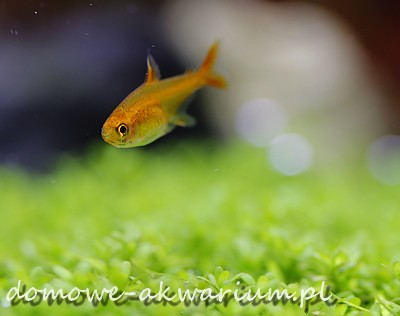
| Species | Ember Tetra |
|---|---|
| Other names | Amanda's Tetra |
| Latin Name | Hyphessobrycon Amandae |
| Family | pike-perches |
| Origin | Ameryka Południoiwa |
| Length | 1,5 - 2,0 cm |
| Temperature | 22 - 28°C |
| Water Hardness | soft - medium hard |
| pH | 5,0 - 7,5 |
| Aquarium Size | 40 L |
| Food | dry, live, frozen |
Ember Tetra, Amanda's Tetra, Fire Tetra, Red Dwarf Tetra
The ember tetra was discovered fairly late, only in 1986. It's a freshwater fish that naturally occurs within the Araguaia River (old river bed, confluence, flooded areas, channels) in the central Brazil.
The ember tetra is characterized by a copper-orange-red body coloration, which is most intense around the head, belly, lateral line and fins: dorsal, anal, and caudal. The rest of the body is more transparent. At the end of the dorsal fin, a pale black spot can be observed. The sexes of the fish are easiest to distinguish during the spawning period - males become more brightly colored, and females become more rounded in the belly areas. Moreover, females are slightly larger than males.
These are active, calm, and sociable fish, which sometimes tend to nibble on other fish's fins. Therefore, they should be kept in a larger group - a minimum of 6-8 individuals. Then, all undesired behaviors are contained within the shoal. We can easily keep them with guppies, other similarly-sized tetras, and rasboras, mollies, spotted mutt fish, Corydoras, or otocinclus catfish. In an overcrowded aquarium and with too large fish, the ember tetra becomes more nervous, skittish, and constantly hides. These are quite hardy fish - they can be recommended for beginner aquarists. They prefer to swim in the middle water layers.

The species can be kept in a community aquarium as well as in a blackwater biotope aquarium. In the first case, the tank should be heavily planted, have numerous hiding places among roots, dark and fine substrate, and diffused lighting (this will be facilitated by floating plants). A gentle water flow from the filter is recommended. In the second case, we put sand on the bottom, the decoration consists of sticks and roots, plants, and dry oak or beech leaves arranged on the bottom of the aquarium (we replace them systematically every few weeks). Diffused lighting (floating pieces of wood) or tea-colored water (peat in the filter or a hanging mesh with peat on the edge of the tank).
The species is oviparous. The fish are best bred in a separate aquarium with chemically mature water, clumps of plants with delicate and small leaves or an egg crate, a special grid protecting the laid eggs. The tank should be very dimly lit, the water slightly acidic or neutral pH, at a temperature of 28ºC. To the breeding aquarium, we transfer a selected pair of fish (the fattest female and the most brightly colored male) or a group of fish (with a numerical advantage of females). The female tetra lays eggs in the water column, scattering them on the bottom of the tank. Parents do not take care of the offspring, quite the opposite they will eat the eggs and fry. Therefore, after the spawning has taken place (2-3 days after being introduced to the breeding aquarium), they should be removed immediately. After 1-1.5 days, larval hatching occurs, and after another 4 days, the fry freely swim in search of food.